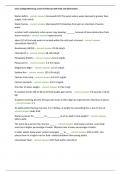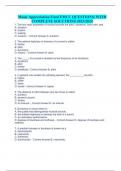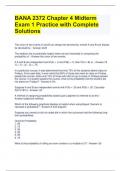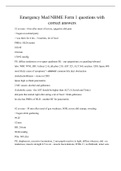Utica College Med Surg 1 test #1 February 4th Fluid and Electrolytes
Water deficit - correct answer (increased ECF) This exists where water demand is greater than
supply. Cells shrink
Water Excess - correct answer (decreased ECF) Develops from gain or retention of excess
water
a patient with metastatic colon cancer may develop _______ because of bone destruction from
tumor invasion - correct answer hypercalcemia
about 2/3 of the body water in located within the cells and is termed - correct answer
intracellular fluid (ICF)
Bicarbonate (HCO3) - correct answer 22-26 mEq/L
Chloride (Cl-) - correct answer 98-106 mEq/L
Phosphate (PO43-) - correct answer 2.4-4.4 mg/dL
Potassium K+ - correct answer 3.5-5.0 mEq/L
Magnesium Mg2+ - correct answer 1.5-2.5 mEq/L
Sodium Na+ - correct answer 135-145 mEq/L
Calcium Ca2+ total - correct answer 8.6-10.2 mg/dL
Calcium (ionized) - correct answer 4.6-5.3 mg/dL
One liter of water weighs - correct answer 2.2 lbs (1 kg)
If a patient drinks 240 ml (8 oz) of fluid weight gain will be - correct answer 0.5 pounds or (0.23
kg)
A patient receiving diuretic therapy who loses 4.4 lb (2 kg) has experienced a fluid loss of about
- correct answer 2 L
An adult patient fasting may lose 1 to 2 lb/day. A weight loss exceeding this is due to loss of -
correct answer body fluid
Water accounts for ________ to ___________% of an adult's total weight? - correct answer
50% to 60%
The more fat a person has, the less _____ - correct answer total water content. Lean body
mass has a higher percentage of water. Women have a lower percentage of water.
In older adults, body water content averages ___ to __ - correct answer 45% to 50%. This
places them at a higher risk for fluid- related problems than young adults.
intracellular fluid - correct answer (ICF) fluid within cells (28 L)
,Utica College Med Surg 1 test #1 February 4th Fluid and Electrolytes
extracellular fluid - correct answer ECF- fluid outside of the cell
Main compartments containing ECF - correct answer - interstitial fluid
- intravascular fluid
- transcellular fluids
interstitial fluid - correct answer fluid in the spaces between cells (10L)
intravascular fluid - correct answer plasma- the liquid part of blood (3L)
Transceullar fluid - correct answer cerebrospinal fluid, fluid in the GI tract, and joint spaces.
Also pleural, peritoneal, intraocular, and pericardial fluid.
ECF makes up ___ of body water - correct answer 1/3 of body water. About 14L in a 70kg man.
1/3 of ECF is the intravascular space as ___ - correct answer plasma (3L) in a 70 kg man, and
2/3 is in the interstitial space 10L
Fluid in the transcellular spaces - correct answer totals 1 L at any given time
Cations - correct answer positively charged ions- Na+ , Ca2+, Mg2+
Anions - correct answer negatively charged ions
- Bicarbonate (HCO3-)
- Chloride (Cl-)
- Phosphate (PO43-)
Most proteins bear a _____ charge and are thus ___ - correct answer negative charge, are thus
anions
In ECF, the main cation is ____ - correct answer Sodium, with small amounts of potassium,
calcium, and magnesium
The primary ANION in ECF is - correct answer chloride, with small amounts of bicarbonate,
sulfate, and phosphate anions
In ICF, the most prevalent Cation is - correct answer potassium, with small amounts of
magnesium and sodium
Prevalent ICF Anion is - correct answer phosphate, with some protein and a small amount of
bicarbonate.
Diffusion - correct answer Movement of molecules from an area of higher concentration to an
area of lower concentration. Stops when both concentrations are equal in both areas. Occurs in
liquids, gases, solids.. NO EXTERNAL ENERGY
,Utica College Med Surg 1 test #1 February 4th Fluid and Electrolytes
facilitated diffusion - correct answer use of protein carrier in the cell membrane. Combines
with a molecule, especially one to large to pass- assists moving molecule from area of high to
low concentration. Passive NO ENERGY
example of facilitated diffusion - correct answer glucose transport into the cell. Large glucose
molecule must combine with a carrier molecule to be able to cross cell membrane and enter
most cells.
Active Tansport - correct answer The movement of a substance across a cell membrane against
its concentration gradient. EXTERNAL ENERGY IS USED
example of active transport is the ___ - correct answer sodium potassium pump. Cell uses
active transport to move sodium out of the cell and potassium into the cell. The energy source
for this is ATP which is made in the mitochondria.
Osmosis - correct answer movement of water down an concentration gradient. Low to high
solute concentration across semi-permeable membrane. NO OUTSIDE ENERGY SOURCES. stops
when concentration differences disappear of when hydrostatic pressure builds and opposes
further movement of water. Concentration of a solution determines the strength of the osmotic
pull
The higher the concentration, the greater a solution pull or ____ - correct answer osmotic
pressure. Measured in millismoles (most). It many be expressed as either fluid osmolarity or
fluid osmolality.
osmolarity measures - correct answer total milliosmoles per liter of solution, or concentration
of molecules per volume of solution
osmolality measures - correct answer number of milliosmoles per kilogram of water, or the
concentration of molecules per weight of water.
_____ is the preferred measure to evaluate the concentration of plasma, urine, and body fluids
- correct answer OSMOLALITY
Plasma osmolality equation - correct answer ( 2 X NA) + (BUN/2.8) + ( GLUCOSE/ 18)
Normal plasma osmolality - correct answer 280 - 290 mOsm/kg
value greater than 295 mOsm/kg indicates that - correct answer the concentration of solute is
too great or the water content is to little. termed WATER DEFICIT
value less than 275 mOsm/kg indicates that - correct answer to little solute for the amount of
water or too much water for the amount of the solute. termed WATER EXCESS
Osmolality of urine - correct answer 100- 1300 mOsm/kg
, Utica College Med Surg 1 test #1 February 4th Fluid and Electrolytes
Urine osmolality depends on - correct answer fluid intake, the amount of antidiuretic hormone
(ADH) in circulation, and renal response to ADH
Fluids with the same osmolality as the cell are termed - correct answer isotonic.
Normally ECF and ICF are isotonic to each other so no net movement of water occurs
solutions in which the solutes are less concentrated that in the cells are termed - correct
answer hypotonic
If a cell is surrounded by hypotonic fluid - correct answer water moves into the cell, causing it
to swell and possibly to burst.
fluids with solutes more concentrated than in cells, or increased osmolality are termed -
correct answer hypertonic
if hypertonic solution surrounds a cell - correct answer water leaves the cell to dilute ECF the
cell shrinks and eventually dies
hydrostatic pressure - correct answer the pressure within a blood vessel that tends to push
water out of the vessel. Is BP in blood vessels, pressure is vascular system decreases as blood
moves through arteries until it is about 30 mm Hg. Pushes water out of vascular system and
into interstitial space
oncotic pressure - correct answer pressure caused by plasma colloids in a solution. Colloids in
vascular system are proteins such as albumin. Plasma protein molecules attract water, pulling
fluid from the tissue space to the the vascular space. Normal plasma oncotic pressure is 25 mm
Hg.
If capillary or interstitial pressure change, fluid may abnormally shift from one compartment to
another resulting in - correct answer edema or dehydration
Edema - correct answer accumulation of fluid is the interstitial space. Occurs if:
- venous hydrostatic pressure rises
- plasma oncotic pressure decreases
- interstitial oncotic pressure rises
- or obstruction of lymphatic outflow causes decreased removal of interstitial fluid
elevation of venous hydrostatic pressure - correct answer Increasing the pressure at the
venous end of the capillary inhibits fluid movement back into the capillary, which results in
edema. Causes include: fluid overload, HF, liver failure, obstruction of venous return to the
heart (tourniquets, tight clothing, venous thrombosis) and venous insufficiency (varicose veins)







